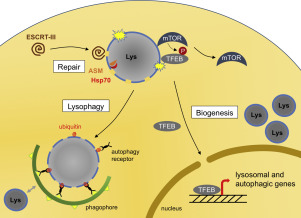当前位置:
X-MOL 学术
›
J. Mol. Biol.
›
论文详情
Our official English website, www.x-mol.net, welcomes your
feedback! (Note: you will need to create a separate account there.)
Repair or Lysophagy: Dealing with Damaged Lysosomes.
Journal of Molecular Biology ( IF 4.7 ) Pub Date : 2019-08-23 , DOI: 10.1016/j.jmb.2019.08.010 Chrisovalantis Papadopoulos 1 , Bojana Kravic 1 , Hemmo Meyer 1
Journal of Molecular Biology ( IF 4.7 ) Pub Date : 2019-08-23 , DOI: 10.1016/j.jmb.2019.08.010 Chrisovalantis Papadopoulos 1 , Bojana Kravic 1 , Hemmo Meyer 1
Affiliation

|
Lysosomal membrane permeabilization or full rupture of lysosomes is a common and severe stress condition that is relevant for degenerative disease, infection and cancer. If damage is limited, cells can repair lysosomes by means of the endosomal sorting complex required for transport (ESCRT) machinery. Presumably, if repair fails, lysosomes are tagged with ubiquitin to initiate clearance by selective macroautophagy, termed lysophagy. Accumulating evidence suggests damage-induced exposure of luminal glycans to the cytosol as the key trigger for ubiquitination. In this review, we discuss recent data on cellular damage sensing, the underlying ubiquitination and autophagy machinery as well as additional layers of regulation such as processing of ubiquitinated proteins by the AAA-ATPase VCP/p97. We conclude with thoughts on how these mechanisms may regulate decision making between lysosome repair and lysophagy.
中文翻译:

修复或溶血:处理受损的溶酶体。
溶酶体膜透化或溶酶体完全破裂是一种常见的严重应激状况,与变性疾病,感染和癌症有关。如果损害受到限制,则细胞可以通过运输所需的内体分选复合物(ESCRT)修复溶酶体。据推测,如果修复失败,则用泛素标记溶酶体,以通过选择性的巨噬细胞自噬(称为溶细胞吞噬)来启动清除。越来越多的证据表明,损伤诱导的腔聚糖暴露于胞质溶胶是泛素化的关键触发因素。在这篇综述中,我们讨论了有关细胞损伤传感,潜在的泛素化和自噬机制以及其他调控层(例如AAA-ATPase VCP / p97对泛素化蛋白的加工)的最新数据。
更新日期:2019-08-25
中文翻译:

修复或溶血:处理受损的溶酶体。
溶酶体膜透化或溶酶体完全破裂是一种常见的严重应激状况,与变性疾病,感染和癌症有关。如果损害受到限制,则细胞可以通过运输所需的内体分选复合物(ESCRT)修复溶酶体。据推测,如果修复失败,则用泛素标记溶酶体,以通过选择性的巨噬细胞自噬(称为溶细胞吞噬)来启动清除。越来越多的证据表明,损伤诱导的腔聚糖暴露于胞质溶胶是泛素化的关键触发因素。在这篇综述中,我们讨论了有关细胞损伤传感,潜在的泛素化和自噬机制以及其他调控层(例如AAA-ATPase VCP / p97对泛素化蛋白的加工)的最新数据。































 京公网安备 11010802027423号
京公网安备 11010802027423号